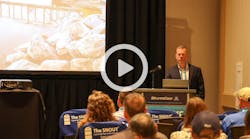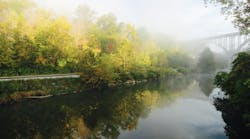Researchers in Japan are studying the effects of radiation in the soil in a 30-kilometer zone around the Fukushima Daiichi nuclear power plant. Damage from the March 2011 earthquake and tsunami caused the plant to release radiation to the environment, leading to widespread evacuations. Now scientists are looking at the properties of the soil in rice fields around the area, including soil-to-plant transfer of radioactive cesium, also called radiocesium.
Although the radiocesium spread rapidly after its release, it can be trapped by soil to a greater or lesser extent depending on the soil’s composition. For example, soils with high levels of minerals like mica retain radiocesium relatively well; the rough edges of the minerals catch and hold the radioactive material and prevent it from spreading further, say scientists at Kyoto Prefectural University, which is conducting the study.
Although the soils contain radiocesium, it’s believed that plants growing in the soils do not readily uptake the material, in part because the same roughness or “frayed edge” properties of the soil that keep the material from migrating also prevent it from transferring to the plants. The mica-rich soils tend to be soils with high clay or silt content.
Researchers in Japan are studying the effects of radiation in the soil in a 30-kilometer zone around the Fukushima Daiichi nuclear power plant. Damage from the March 2011 earthquake and tsunami caused the plant to release radiation to the environment, leading to widespread evacuations. Now scientists are looking at the properties of the soil in rice fields around the area, including soil-to-plant transfer of radioactive cesium, also called radiocesium.
Although the radiocesium spread rapidly after its release, it can be trapped by soil to a greater or lesser extent depending on the soil’s composition. For example, soils with high levels of minerals like mica retain radiocesium relatively well; the rough edges of the minerals catch and hold the radioactive material and prevent it from spreading further, say scientists at Kyoto Prefectural University, which is conducting the study.
Although the soils contain radiocesium, it’s believed that plants growing in the soils do not readily uptake the material, in part because the same roughness or “frayed edge” properties of the soil that keep the material from migrating also prevent it from transferring to the plants. The mica-rich soils tend to be soils with high clay or silt content.
[text_ad]Soils with a high percentage of organic matter, on the other hand, do not retain radiocesium as well. Scientists speculate this is because of their higher carbon, higher phosphate absorption, and lower acidity.
The study’s results are published in the Journal of Environmental Quality.
Soils with a high percentage of organic matter, on the other hand, do not retain radiocesium as well. Scientists speculate this is because of their higher carbon, higher phosphate absorption, and lower acidity.
The study’s results are published in the Journal of Environmental Quality.
About the Author
Janice Kaspersen
Janice Kaspersen is the former editor of Erosion Control and Stormwater magazines.

